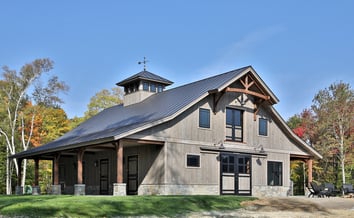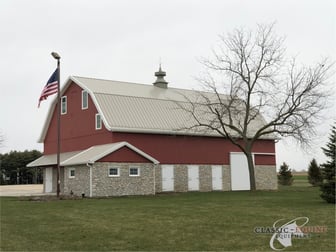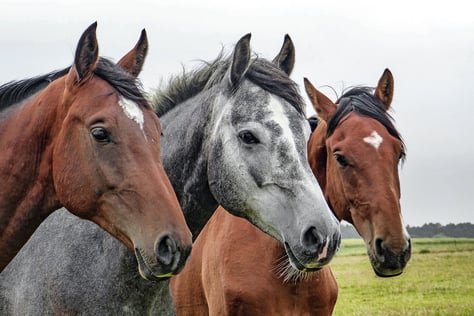Call us today (800) 444-7430
Call us today (800) 444-7430
 A Pole Barn (Post Frame) framing utilizes posts and beams to minimize the number of framing elements in walls. It is economical, strong and relatively simple to build, making it the most popular framing method for custom barns. A pole barn frame consists of 6- to 8-inch round or rectangular pressure-treated wood posts set 3 to 6 feet below the ground. Poles are typically set at 8- to 12-foot intervals and rest on a pad of concrete at the bottom of each hole. Poles and trusses or rafters are generally visible inside the barn. Pole barns are easy to build in part because they require no trench work for a foundation, only holes; and these can be dug using a tractor auger or a hand posthole digger.
A Pole Barn (Post Frame) framing utilizes posts and beams to minimize the number of framing elements in walls. It is economical, strong and relatively simple to build, making it the most popular framing method for custom barns. A pole barn frame consists of 6- to 8-inch round or rectangular pressure-treated wood posts set 3 to 6 feet below the ground. Poles are typically set at 8- to 12-foot intervals and rest on a pad of concrete at the bottom of each hole. Poles and trusses or rafters are generally visible inside the barn. Pole barns are easy to build in part because they require no trench work for a foundation, only holes; and these can be dug using a tractor auger or a hand posthole digger. type of post and beam construction, but rather than plugging into the ground like a pole barn, a timber frame barn sets on a concrete foundation. A properly constructed timber frame is incredibly sturdy–some have lasted for hundreds of years. It is typically comprised of 8- and 10-inch square timbers for main members and smaller timbers for roof purlins and floor joists. Major joints are traditionally dovetails and mortise and tenon, often hand cut and secured with wooden pins, like fine furniture
type of post and beam construction, but rather than plugging into the ground like a pole barn, a timber frame barn sets on a concrete foundation. A properly constructed timber frame is incredibly sturdy–some have lasted for hundreds of years. It is typically comprised of 8- and 10-inch square timbers for main members and smaller timbers for roof purlins and floor joists. Major joints are traditionally dovetails and mortise and tenon, often hand cut and secured with wooden pins, like fine furniture construction on a larger scale. Craftsmen using traditional timber frame methods don’t use nails or other metal fasteners unless they are required by local codes. Timber frame barns are sometimes built in or near the builder’s shop and shipped to the site to be erected by the builder, a local contractor or the owner. Timber-frame kits that use metal connectors to secure joints are available
construction on a larger scale. Craftsmen using traditional timber frame methods don’t use nails or other metal fasteners unless they are required by local codes. Timber frame barns are sometimes built in or near the builder’s shop and shipped to the site to be erected by the builder, a local contractor or the owner. Timber-frame kits that use metal connectors to secure joints are available One pole barn (or post-frame) style is called the Full Monitor or Raised Center Aisle barn. It has a high center raised roof that lets hot air rise above the stalls and horses. The design also allows skylights and windows to be installed on each side of the center roofline, letting in more light and additional fresh air. The monitor has essentially two shed roofs with a gable in the middle. This is good for long rows of stalls.
One pole barn (or post-frame) style is called the Full Monitor or Raised Center Aisle barn. It has a high center raised roof that lets hot air rise above the stalls and horses. The design also allows skylights and windows to be installed on each side of the center roofline, letting in more light and additional fresh air. The monitor has essentially two shed roofs with a gable in the middle. This is good for long rows of stalls. It offers the benefit of a large loft located above the stalls for added storage. The Gambrel has a double-pitched roof popular on two-story barns having a second floor because of the increased headroom and useable floor space it allows. Gambrel trusses eliminate the need for interior post and beam supports, which allows you to create any floor plan you wish.
It offers the benefit of a large loft located above the stalls for added storage. The Gambrel has a double-pitched roof popular on two-story barns having a second floor because of the increased headroom and useable floor space it allows. Gambrel trusses eliminate the need for interior post and beam supports, which allows you to create any floor plan you wish.

From horse stalls to barn doors, stable flooring and entrance gates, Classic offers the widest product lines in the industry while continuing to expand through innovation and strategic alliances.
We look forward to answering your questions. Our sales team is knowledgeable about everything from horse barn design to equine stall systems and readily available to assist you in planning your Classic barn!
ph: (800) 444-7430
em: sales@classic-equine.com
